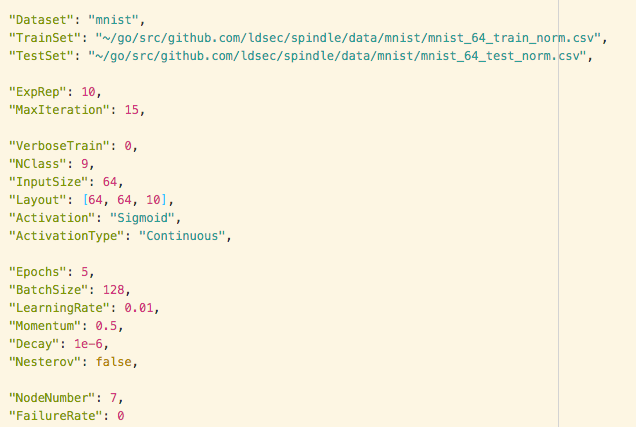In this project we build a prototype of distributed neural network model with decentralized servers. The main goal of these prototypes is to study the effects on distributed neural network model capacity of:
- Data decentralization
- Server failure
The project is in the protocols/benchmarking folder from the Spindle project
To run the project you must install the go-deep library:
- The official version can be downloaded with the following command:
go get github.com/patrikeh/go-deep- A modified version of this library with approximated activation function:
go get github.com/raphaelreis/go-deep-modInstall the Spindle repo
go get github.com/ldsec/spindleThe protocols configuration's parameters can be modified in the config.json file from the config folder. Parameters that are not used in the centralized protocol are not parsed (e.g: "NodeNumber", "FailureRate") and don't need to be removed from the configuration file.
A typical exemple of configuration for the mnist dataset is:
where parameters are:
-
"Dataset": the name of the dataset. So far there is mnist, breast cancer and diabete are recognized. Values
- MNIST: "mnist"
- Breast cancer: "bc"
- Diabete: "diabete"
-
"TrainSet", "TestSet": the path to the train test sets files.
-
"ExpRep": the number of experiment repetition
-
"MaxIteration": the number of iteration bottom-up/top-down passes.
-
"VerboseTrain": verbosity of the training phase. In decentralized protocol, with many nodes, verbose training can become undreadable. Values:
- 0: no information about node training
- 1: train time | loss value | accuracy
-
"NClass": the number of classes for a classification task.
-
"InputSize": the number of data set's features
-
"Layout": the architecture of the deep network. It must typically be a list of integers (e.g.[64, 64, 10]). The last integer is the last layer's number of neurons.
-
"Activation": the activation function for each hidden layer. So far, sigmoid and relu are implemented.
-
"ActivateType": if you download the official go-deep library, no need to change these parameters. However, if you download the go-deep-mod library, this parameter allow you to chose between continous activation function or approximated one.
- "Continuous": continuous activation function
- "Approx": Taylor Series approximiated activation function
-
"Epochs", "BatchSize", "LearningRate", "Momentum", "Decay", "Nesterov": the optimization parameters/hyperparameters.
For decentralized protocol only:
- "NodeNumber": the number of nodes in the decentralized system
- "FailureRate": the probability for each server to fail at the begining of the protocol. A server fails at the beginning of the protocol and never come back to a working mode.
The experiments are run with Go tests. Since the default go test timeout is 10 minutes, you must add a -timout flag to extend this duration (e.g.: -timeout 3h)
Centralized
To run the centralized protocol, cd to the centralized repo and run:
go test -run TestCentralizedLearning -v -timeout 3hDecentralized
To run the decentralized protocol, cd to the decentralized repo and run:
go test -run TestDecentralizedLearning -v -timeout 3hTo parametrize the protocols, both centralized and decentrlized use the conf.go file.
To add a new parameter to the protocol, first add the parameter in the confstruct in the conf.go file. Then add the value to the config/config.json file with a specified value.
It is not mandatory to add a parameter to both protocols (e.g. see NodeNumbers, FailureRate parameters).
Then in the protocol, you can access the specified value with conf.WhatEverValueYouLike for centralized protocol and p.ProtocolConf.WhatEverValueYouLike for decentralized protocol.
To build neural network input from raw csv, we rely on the dataloader.go file.
To add a new dataset, you need to implement a new ToExample function. This function is a csv parser. See for example the function to parse the mnist dataset:
func mnistToExample(in []string) training.Example {
res, err := strconv.ParseFloat(in[len(in)-1], 64)
if err != nil {
panic(err)
}
resEncoded := onehot(10, res)
var features []float64
for i := 0; i < len(in)-1; i++ {
res, err := strconv.ParseFloat(in[i], 64)
if err != nil {
panic(err)
}
features = append(features, res)
}
return training.Example{
Response: resEncoded,
Input: features,
}
}You must also modify the if statement in the Load function to parse the data set parsing function correctly. See:
if dataset == "mnist" {
toExample = mnistToExample
} else if dataset == "bc" {
toExample = bcToExample
} else if dataset == "diabete" {
toExample = diabeteToExample
} else {
...
toExample = yourNewDataSetToExample
}Raphaël Reis Nunes
